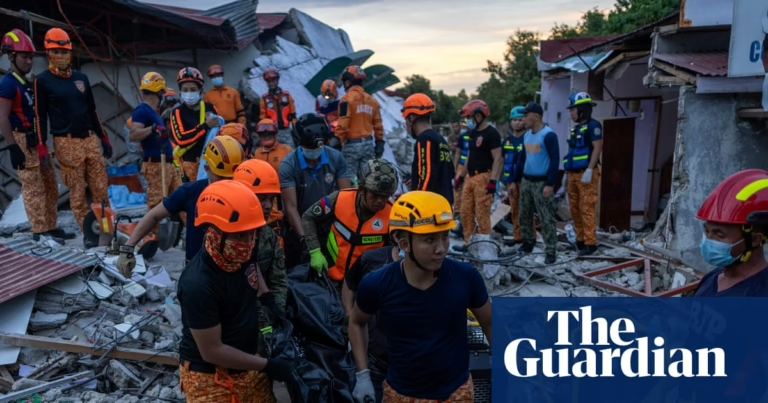In the aftermath of the deadliest earthquake in over ten years, rescue teams in the Philippines tirelessly searched through debris and mud, as the disaster claimed at least 69 lives and overwhelmed medical facilities on Cebu Island.
At the Cebu provincial hospital, the scene was chaotic on Wednesday, with injured children wailing and adults crying out in pain while receiving treatment on beds set up under blue tarps outside. This precaution was taken due to the ongoing threat of aftershocks.
The earthquake, registering a magnitude of 6.9 and occurring at a shallow depth, struck late Tuesday near Bogo, a city with a population of approximately 90,000, according to the Philippine Institute of Volcanology and Seismology (Phivolcs).
By Wednesday evening, Phivolcs had documented over 700 aftershocks, most of which were minor tremors.
Rescue personnel conducting search operations amid collapsed structures in Bogo.
Phivolcs warned that aftershocks are expected to continue in the epicenter region, potentially lasting from several days to weeks, and may also be felt in neighboring provinces.
At the provincial hospital, staff were seen loading black body bags into vans destined for local morgues.
Rafaelito Alejandro, deputy administrator of the Office of Civil Defense, reported on local TV that many victims had been trapped under rubble, which led to their deaths, confirming the death toll at 69.
A vehicle crushed beneath debris from partially collapsed buildings in Bogo.
Richard Guion, 39, with a heavily bandaged left elbow, recounted how his 17-year-old son, who was outside playing when the quake hit, rescued him and his wife-who suffered a broken foot-from beneath their collapsed concrete wall. “When the cement gave way, I called out to him,” Guion said, grateful his son had ignored his earlier instruction to go to bed early.
The damaged Santa Rosa de Lima shrine in Cebu.
Alejandro detailed the casualties by location: 30 fatalities in Bogo, 22 in San Remigio, 10 in Medellin, five in Tabogon, and one each in Sogod and Tabuelan. The hospital in Bogo reported 186 injured individuals so far.
In Bogo, firefighters operated excavators to bore through the rubble of a collapsed two-story motel, where two receptionists and a child were feared trapped beneath the wreckage.
Among the anxious onlookers was Isagani Jilig, 41, whose wife and child remain missing. “I won’t leave this place until I find them. As a father, I must stay strong now more than ever,” he said.
Firefighter Erwin Castaneda expressed determination despite the long hours of searching: “We have been at it for five hours, but giving up is not an option. These are lives at stake, and we will do everything possible.”
Civil defense teams also combed through a landslide site in the city, where at least 14 people lost their lives. Cebu provincial information officer Ainjeliz Orong cautioned that the death toll might rise as rescue efforts continue.
Rescue operations have been complicated by heavy rainfall and power outages. The Cebu provincial government has appealed for medical volunteers via its official Facebook page to support the overwhelmed healthcare system.
President Ferdinand Marcos vowed rapid assistance for those affected, offering his deepest sympathies to the families who lost loved ones.
Dashcam footage captures people being jolted off their motorcycles as the earthquake shakes the Philippines – video
Powerful video recorded by locals on Bantayan Island, near Cebu, showed a series of lightbulbs swinging violently inside an old Catholic church before its bell tower collapsed into the courtyard. Broadcasts also displayed motorcyclists dismounting and gripping railings as a bridge in Cebu swayed dramatically.
In response to the crisis, local authorities have implemented price controls on essential goods and fuel to ensure availability for those impacted by the earthquake.
Vehicles navigate a fissure along a major highway in Tabogon town, Cebu province.
Situated along the Pacific “Ring of Fire,” a zone known for intense seismic activity stretching from Japan through Southeast Asia and across the Pacific, the Philippines experiences earthquakes almost daily. Cebu, in particular, is prone to such seismic events.
While most tremors are too faint to be noticed, destructive earthquakes occur unpredictably, with no current technology capable of forecasting their timing or location.






















